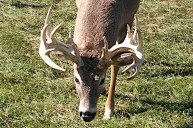Dozens of deer have been found dead in a Northern Pennsylvania county due to an outbreak of a deadly disease, according to the Pennsylvania Game Commission.
On September 8, 30 to 40 deer were found dead near State Game Lands 214 in Sadsbury and North Shenango townships. Officials said the deer died from hemorrhagic disease (HD), which is spread through biting midges. Midges are small flies with single wings that look similar to mosquitos and are often found by water.
Hemorrhagic disease is caused by one of two viruses: either bluetongue virus or epizootic hemorrhagic disease virus. According to the Game Commission, outbreaks of these diseases typically happen in fall. Much like mosquitos transmitting West Nile virus, midges pick up the virus from an infected host and transfer it to the next deer they bite. Thankfully, there is no human transmission nor deer-to-deer transmission of the disease.
Both deer and elk herds are susceptible to the infection, though whitetail deer are most likely to contract the disease and die, according to data the Commission has collected over the last couple of years.
According to a press release, the Game Commission monitors "HD to keep track of what viral strains occur from year to year, as well as determine if there are population-level implications." So far, there haven't been any negative impacts on deer populations. Every time an outbreak hits, the population recovers.
Over the last couple of years, the Game Commission notes, midge distribution has expanded northward, from traditionally moist environments to higher, drier regions. As a result, the disease is affecting deer and elk populations that have never encountered it before. Iowa, Illinois, Michigan, Ohio, Wisconsin, and Nebraska have all seen recent outbreaks.
Minnesota saw its first outbreak in 2019. According to the Minnesota Department of Natural Resources, the disease has a 5-10 day incubation period, and deer or elk die within 36 hours of exhibiting symptoms. The feverish deer are driven toward water and die from internal lesions and hemorrhages.
The Pennsylvania Game Commission does point out that HD is not a risk to humans or pets but "urges the public to remain at a safe distance when observing wildlife and to not handle wildlife unless they are hunting, trapping, or otherwise authorized to do so." Don't eat the meat of an infected deer or elk.
The Commission is still collecting information on animals affected by the disease and is asking the public to report suspected cases of two or more deer. Dead deer can be reported by calling the Commission at 1-833-PGC-WILD or through the Commission's Wildlife Health Survey tool. Citizens can report other sick or injured wildlife through the site as well.
READ MORE: New Study Says Ticks Could Be Spreading Chronic Wasting Disease




